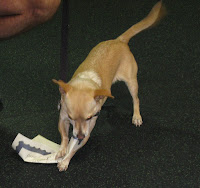I can't tell you how excited I am about our new president elect Barack Obama! Like many, I cried tears of joy November 5th while looking at the front page of the newspaper. Now, I'm not going to use my dog training blog for political opinions beyond my excitement about change etc... but I would like to voice my sentiments regarding the ever popular "new puppy".
I think it's wonderful that the Obama's are planning to adopt a new puppy once they move into their new home. What a perfect situation: loving family, huge fenced yard, staff to help keep puppy occupied while the kids are at school and mom and dad are at work, private plane so they can take their dog with them and not have to board them somewhere or stick 'em in cargo, financially secure to buy everything from food, toys, clothing, and health care. And hey, all those folks wearing dark sunglasses and wires in their ears are great for proper puppy socialization!
This is what I'm a little "concerned" "conflicted" "confused" about: their daughter Malia is "allergic" to dogs yet they're going to bring one into the home because she "wants" one. Now, if she were allergic to peanuts would they give her peanut butter because she wants it? I think not. So why the dog? Here are a few questions I have for Mr. and Mrs. Obama:
- Is Malia really and truly "allergic" to dogs? Anaphylactic reaction: throat closes, can't breathe, heart races etc... If so, what are you thinking!!!?
- Or is she "sensitive" to dogs? Doesn't have the breathing/heart rate issues, but if she plays with them (dogs) for prolonged periods her eyes itch, throat is scratchy, stuffy nose etc...maybe skin irritation.
- Is it the actual dog? OR is it everything the dog rolls and plays in!!! This is probably more common. I have this issue myself. My dog Poncho rolls in grass etc... then I go play with him which results in symptoms of sensitivities. Solution: give him a bath.
- Have you had your daughter allergy tested? If so, and she truly is allergic to dogs, then getting a "hypoallergenic" dog might end up creating a false sense of security, especially if she has environmental allergies too.
My first suggestion: have your daughter tested! (if you haven't done so already). If she isn't allergic to dogs, but pollens, grasses, and other environmental triggers, then you might have more options on which type of dog to get. Also, sensitivities change as we get older. She may become more or less sensitive to certain triggers.
Another sentiment I'd like to express is in regards to which dog to adopt: dogs are living breathing creatures that have individual personalities! They're NOT inanimate objects like furniture, cars and computers. I am NOT breed biased. I am a strong believer that dogs should be adopted based on personality- behavior and demeanor etc... when you first meet them. Not shopping through a "catalog" picking out the one you think is best because of their history of how they were bred.
Remember, you can train/teach a dog to love or hate almost anything (I say almost because I doubt I could train Poncho to hate lamb - and why would I want to?). You can also train any animal to do anything they are physically and mentally capable of doing - unless there is a true mental issue.
YES, dogs were bred for specific traits. So, along with their doggy DNA making them dogs, breed specifics will make that DNA a little stronger in some areas than others - terriers vs hounds vs Cavaliers etc... But, remember, they're still dogs!
So, to the Obama family I say: if you are going to get a dog, please properly investigate which dog is best for all of you based on your needs and desired goals, not on what everyone else says to get. Meet lots of different dogs. Keep in ming there are no guarantee's how any dog will behave under certain circumstances, after all we all have triggers and thresholds.
Also remember that just like raising human children, raising a happy and healthy dog both mentally and physically (including the prevention of behavioral issues), is based on proper education and socialization! Educate yourselves first!
Oh, and BTW, I vote that the pups name be "Chief" - "Hail to the Chief", get it??? ;-)
 Two paw's up for our BIG event last Sunday! The Holiday Boutique Open House Benefiting our local
Two paw's up for our BIG event last Sunday! The Holiday Boutique Open House Benefiting our local 




